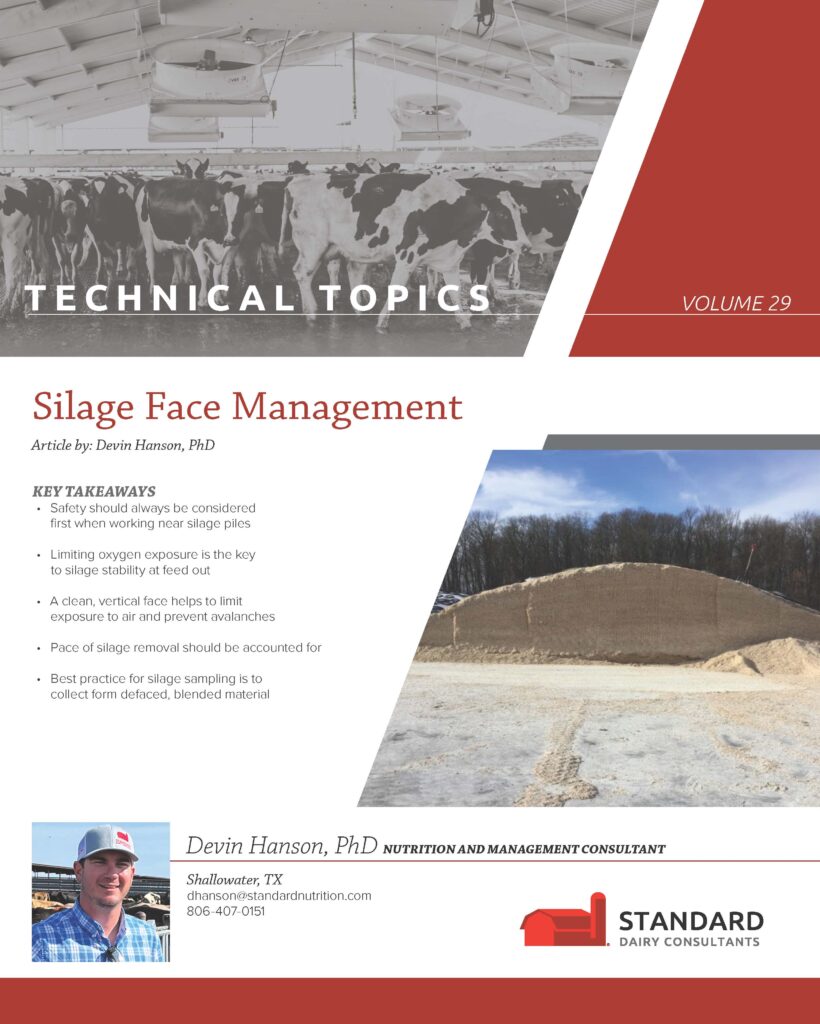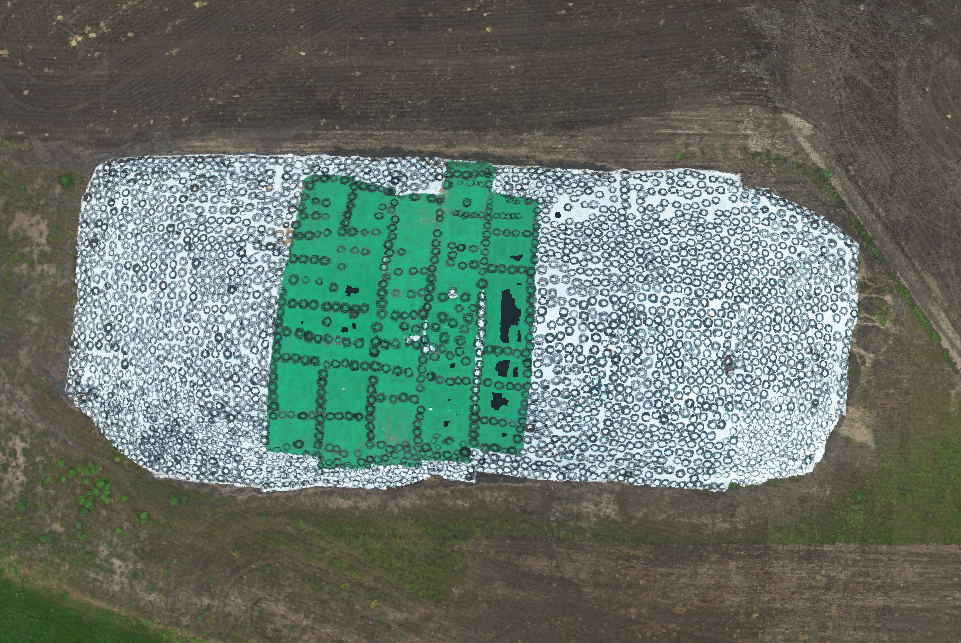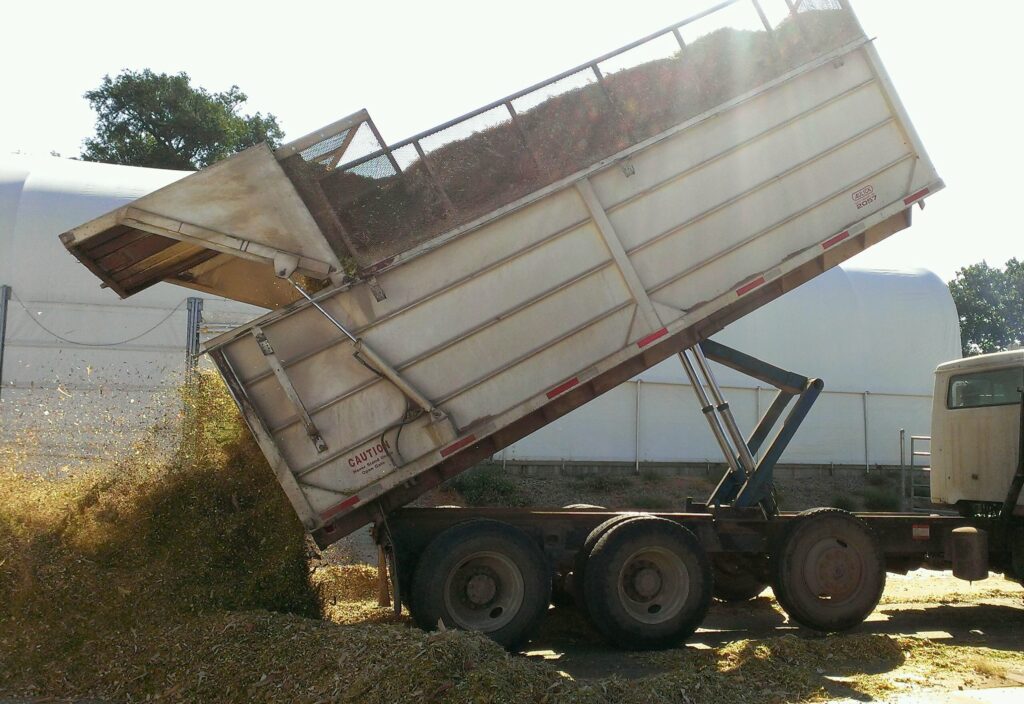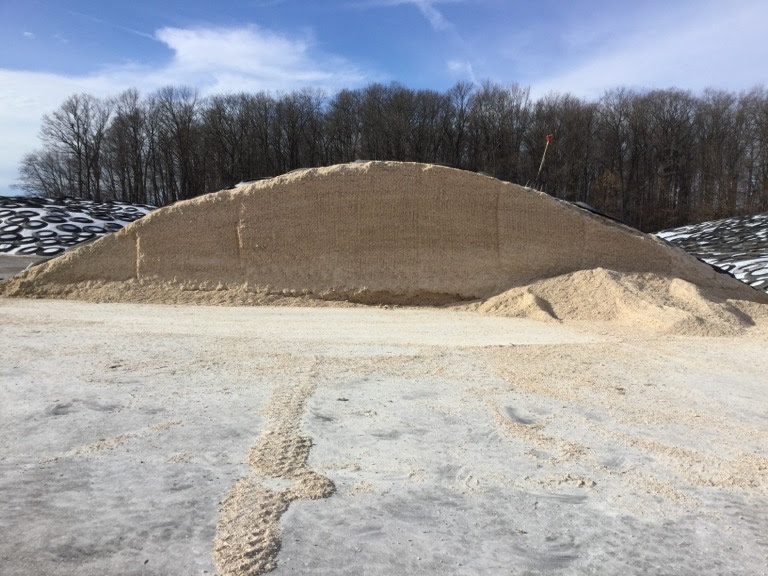Written by: Devin Hanson, PhD
KEY TAKEAWAYS IN THIS ISSUE OF TECHNICAL TOPICS:
- Safety should always be considered first when working near silage piles
- Limiting oxygen exposure is the key to silage stability at feed-out
- A clean, vertical face helps to limit exposure to air and prevent avalanches
- Pace of silage removal should be accounted for
- Best practice for silage sampling is to collect form defaced, blended material

Careful silage face management is a key step to take the valuable silage crop which was meticulously grown, harvested, and fermented, from the storage facility to the feed bunk. The hardest work has (or will nearly be) done at the time of this article. A highly digestible forage has been prepared and is ready to be presented to the herd to be converted to milk production or growth. This is when some people enter “relax mode” — now is not the time to relax but to focus on the critical management it takes to bring all the previous attention to detail to completion. The primary goals of silage face management are to minimize oxygen exposure to the silage, maintain a smooth face, and remove enough of the silage to keep feed that is fed fresh.
The result of poor face management of a silage pile, bunker, or bag will provide a feed with a higher pH than desired, a higher temperature than expected, and aerobic instability resulting in a shorter bunk life. All these elements culminate in a feed that cattle will consume less aggressively.
The priority in any bunker or pile face management is SAFETY. Avalanches do happen and can have serious, if not lethal, consequences. There is no way to predict when or where an avalanche will occur. The best-maintained faces can have weak spots that could break away and injure someone. When this silage falls, it can involve many tons of material, and it can spread across the feed pad for several feet. Anyone working near a bunker or pile should have a buddy with them, or at the very least, make sure that someone knows that they are working in the area. It is also best to park a vehicle nearby so that people can quickly identify where a person might be if an avalanche should occur, and someone appears to be missing. Individuals should not approach a bunker or pile within 3 times the height of the face. It is very easy to become complacent with silage face safety, but a few seconds can change someone’s life forever.

Minimizing oxygen exposure is key to maintaining the preserved quality of the silage. The presence of oxygen allows yeast to grow. Yeast will metabolize lactic acid, which is the primary acid of fermentation, that serves to keep the pH low in the forage to stabilize the silage. This increase in pH begins a cascade of events in the silage. Fungi can start to prosper, which can produce mycotoxins in the feed. Undesirable bacteria can propagate risking an inappropriate secondary fermentation resulting in spoilage of the forage. Nutrients are consumed during this destruction of the silage which reduces the feeding quality of the material to animals for which it is intended. Oxygen exposure can result in dry matter losses in silages by as much as 10% or more. Bunkers should be covered with plastic as quickly as possible after the material is packed in place. The plastic should be 6-8 mil in thickness and tires should be touching when placed on the pile or bunker to reduce the chance of wind disrupting the cover. Oxygen barrier material is available on the market and has shown to be very effective in aiding in silage preservation. In a perfect world, if weather interrupts the harvest, covering the pile or bunker is preferred.

Maintaining a smooth face on the bunker, pile, or bag not only looks good in photos but it is also very important in maintaining the quality of the feed. This face should be perpendicular to the ground or the floor. This straight face can reduce the amount of exposed material by up to 9% on account of simple geometry. The cleanly maintained face is also less inclined to fall in an avalanche, especially compared to a face that has been undermined at its base. Water will not accumulate in pockets when the face is well maintained. A ‘clean’ or well-groomed face can be accomplished by various means. Mechanical defacers and silage rakes for loaders are the two most common means to peel silage from the face of bunkers and piles. The use of a defacer can reduce oxygen exposure by up to 3%. The amount defaced daily should only be what is needed for the day. An important consideration is that the height of the stored feeds should not exceed the reach of the defacing equipment. This is critical for the safety of the loader operator and others working in the area.
Progressing through the pile, bunker, or bag at an adequate pace of feed out is another key factor to maintaining feed quality. Defacing should be at the rate of 6 to 12 inches per day during cold weather and 18 inches during warm seasons. Unfortunately, these parameters are at the opposite of the intake drive of the cows, which is stronger during cold weather and reduced during warm weather seasons. Ideally, these storage units should be sized to remove at least 12 to 15 inches of the face daily to remove the effects of season on face management. Even in well-packed silage, air can penetrate three feet into the silage face. If only six inches are removed, this can result in silage being exposed to air for one week before being fed. This can be detected by measuring the temperature on the face. A guideline is that the temperature inside the pile should be within 15 degrees of the ambient temperature at the time of harvest and within 15 degrees of the silage at the surface. Minimizing the amount of silage defaced will reduce the material that is dried out by the sun and exposed to oxygen. Loading the mixer will be more accurate with freshly defaced silage. If the face of the pile, bunker, or bag gets out of condition, the removal of 3-4 feet should be the first step to getting back into preserved material.
When removing the plastic covering of the pile, no more than 3 days should be exposed at a time. This is also the time to safely remove any spoiled feed from the top of the bunker or pile. The rate of plastic removal will be determined by the face usage and availability of labor to help with this task.

Sampling for feeds stored in piles or bunkers should be done with caution. It is best to deface the material from across the face. Collect the silage to a safe location or put it in the mixer to blend the feed for sampling. Take the sample from this silage that has been mixed or blended for lab analyses or dry matter determinations.
SELECTING AN INOCULANT
Written by: Brian Vaassen
Whether selecting a ‘last minute’ inoculant for this year’s silage harvest or looking ahead to pre-booking for 2025, the following considerations should be kept in mind when surveying the options:
- Research – is the product supported by peer-reviewed, published data?
- It is all about the bugs – what microorganisms are present in the inoculant, and at what concentration?
- Technical support offered – what on-farm service/support does the supplier provide at harvest and throughout the year?
Research. The use of research to verify an inoculant’s effectiveness is essential. Peer-reviewed, independently studied, statistically analyzed, and published in The Journal of Dairy Science or The Journal of Animal Science is a great start. More research showing the benefits of the inoculant completed over multiple years and different crops further increases its odds of repeating success on your silage. One could assume that less than 20% of inoculants have this type of published data, so proceed cautiously! For example, companies will sometimes create brochures showing “research data” from studies done by universities that were never published.
Bugs. There is a considerable variation in the numbers of epiphytic lactic acid bacteria on growing crops and at varying stages of maturity. Because there is no easy method to determine bacterial content before ensiling, one should inoculate. Inoculation with a live inoculant should help direct the fermentation toward lactic acid production. Unfortunately, not all bugs are created equal. Some work over the entire range of pH in silages, while others work in select pH ranges. Commonly found homolactic bacteria include Lactobacillus plantarum, Enterococcus faecium, and several strains of Pediococci. In some studies, combinations of bacteria have increased efficacy, but all combination products are not necessarily better than a single strain of bacteria. These bacteria will improve the initial fermentation process by speeding up lactic acid production, which will drop the pH quickly. Homolactic bacteria only affect pH drop and are not very effective in altering the aerobic stability of silage or what some call “shelf life.” On most farms, a high percentage of dry matter losses in a silo, bunker, or pile is due to poor aerobic stability, not just fermentation losses.
The industry standard for the final application rate of homolactic acid bacteria is 100,000 colony-forming units per gram of fresh forage. This is the amount needed for the product to be effective. One should check product documentation or labels (paying close attention to units) to ensure adequate concentrations of bugs will be present following manufacturer application instructions.
To help aerobic stability, we would need to use a heterotactic acid bacteria; the only acceptable silage inoculant to do this is Lactobacillus buchneri. By itself, Lactobacillus buchneri has minimal effects on up-front fermentation. But, during storage and typically after 45 days, it will convert generous amounts of lactic acid to a moderate amount of acetic acid. Acetic acid is a strong acid that is a potent inhibitor of yeast and molds, which typically are the main culprit in creating aerobic stability issues. A few research-proven inoculants have combined homolactic and heterolactic bacteria to cover the broad spectrum of initial fermentation and help stabilize silage to decrease further losses during storage.
Technical Support. One must always consider technical services and on-farm support from your inoculant provider. These services will not directly correlate to the effectiveness of a silage inoculant, but you should consider them in your decision on which inoculant to purchase. They can provide vital support by:
- Providing inoculant in a timely matter
- Helping ensure it has been appropriately handled until it gets to your farm
- Helping make sure applicators are calibrated correctly
- Making certain distribution on the chopper is covering the entire crop
- Guidance to make sure your inoculant survives during application
- Providing support to choppers during harvest
- Helping to determine proper density in your structure while packing
- Taking samples throughout the year to make sure the inoculant is doing its job
- Providing feed-out rates during the year to maximize the best silage possible
In summary, it is important to remember the following: the more published research, the better; not all inoculants are the same (bugs), and the manufacturer’s reputation and support offered. Cost alone should not be the primary factor in your decision-making, as quality control and handling are also important and may often improve the return on your investment.


